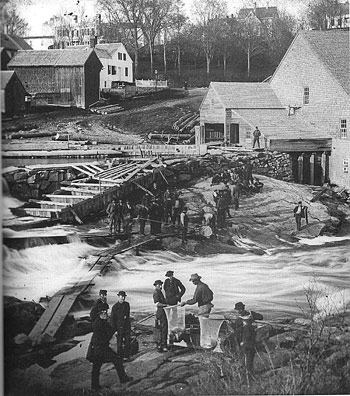Alewives And Harvesters See Strength In Numbers
by Catherine Schmitt
|
Since coming together in 2008, the Alewife Harvesters of Maine have been a busy group, engaging in rulemaking processes at the state and federal levels and working with biologists to gather data on Alosa pseudoharengus, while taking time out to celebrate the alewife season. Their efforts were rewarded this spring, with favorable legislation, scientific discoveries, and strong runs of fish.
Earlier this year, the Maine Legislature passed LD 151, An Act to Amend the Alewife Fishery, which Department of Marine Resources (DMR) submitted to clarify commercial harvesting rules. The amendments allow DMR to lease fishing rights in any river or stream not managed by a municipality. Three-day closures are still mandatory but do not necessarily have to be from 6 a.m. Thursday to 6 a.m. Sunday, to allow for conservation as well as a consistent bait supply to lobstermen.
In May, the Atlantic States Marine Fisheries Commission approved Amendment 2 to the Interstate Fishery Management Plan (FMP) for Shad and River Herring. The Amendment prohibits commercial and recreational fisheries beginning in 2012, unless a state or jurisdiction develops and submits for approval a sustainable management plan by January 1, 2010. State plans will have to demonstrate that local fisheries meet the council's definition of a sustainable fishery: “a commercial and/or recreational fishery that will not diminish the potential future stock reproduction and recruitment.”
continue
|

First Falls of the Medomak River, Waldoboro, Maine. Dip netting alewives, spring, 1874. The town voted in a six-year moratorium on the taking of alewives the following year. In order to allow alewives to reach spawning grounds, fishing was limited to three days a week when it re-opened. Recent decades have brought new challenges to the alewive stocks. Photo courtesy of Lincoln County Historical Association |
|
Free Lunch
Foraging The Maine Seashore
by Tom Seymour
|
Maine’s original inhabitants knew well the edible plant bounty available along our rocky coast. Plants of all sorts grow above and below the mean, high tide line and many of these plants are not only edible but also tasty and healthful. Vitamins, minerals and trace elements abound in seaside plants.
When Europeans colonized what is now Maine, they quickly took advantage of these wild edibles. Generations of coastal Mainers have not only enjoyed, but also depended upon our seaside plants as staple foods. But with the advent of supermarkets, frozen foods and fresh produce shipped here from around the globe, our seaside plants have fallen into disuse. The wheel of time turns slowly but relentlessly and now many Mainers are re-discovering what their ancestors already knew. The Maine seashore is a rich source of edible, wild plants.
continue
|
| The leathery leaves of the Juneberry shrub are similar in form to apple leaves. The berries shown here are not ripe yet. Tom Seymour photo |
|
|

